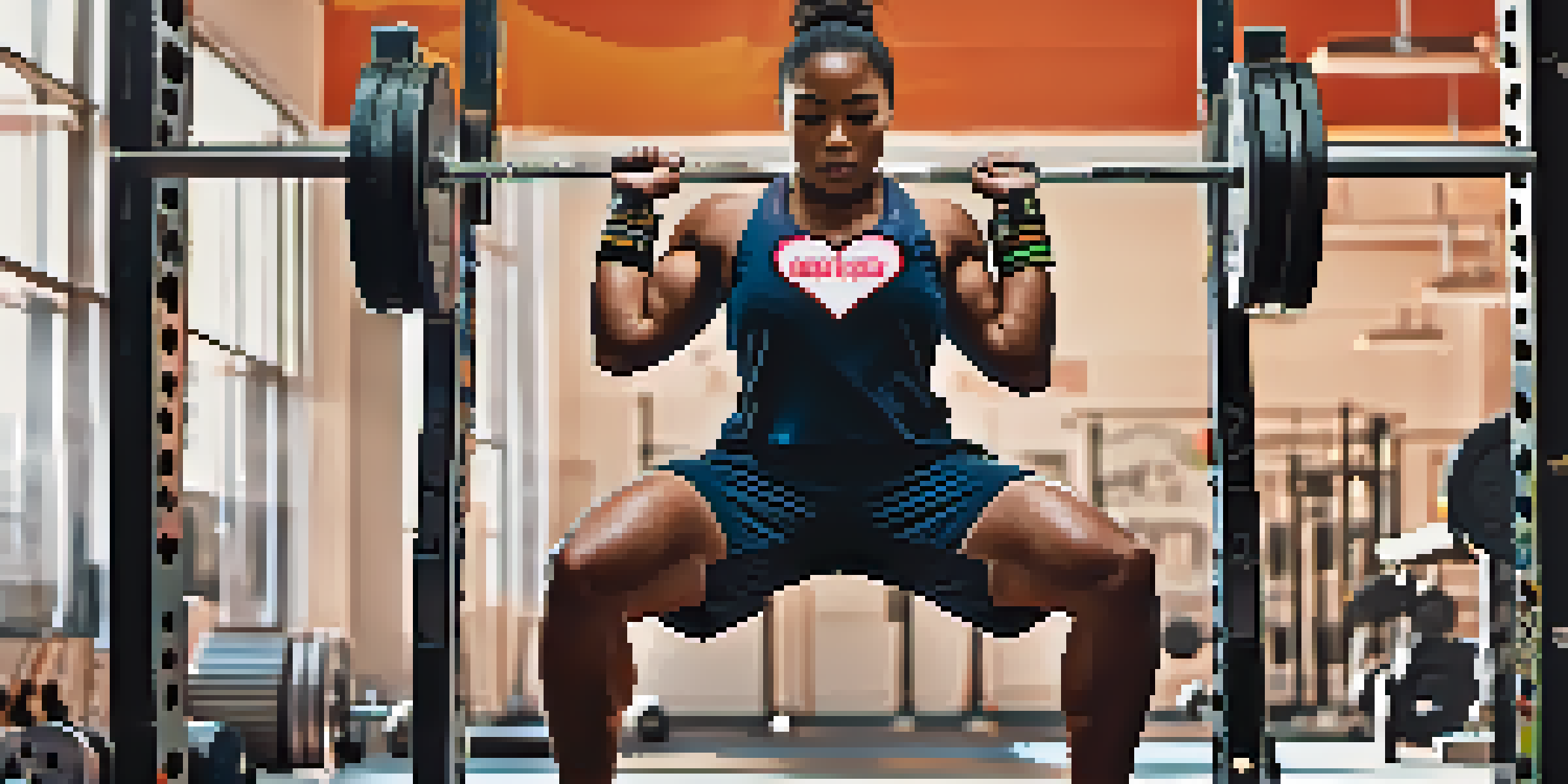Tracking Progress: Biofeedback Tools for Powerlifting Athletes

Understanding Biofeedback in Powerlifting Training
Biofeedback is a technique that helps athletes gain insights into their body’s performance through real-time data. For powerlifting athletes, this means receiving immediate feedback on their physical state during training sessions. By understanding their body's response, lifters can make informed adjustments to improve their technique and strength.
What gets measured gets managed.
This process involves using various sensors and devices that monitor physiological metrics like heart rate, muscle tension, and even movement patterns. Imagine wearing a smart band that not only tracks your heart rate but also alerts you if your muscle tension indicates fatigue. Such tools can significantly enhance training effectiveness by allowing athletes to fine-tune their performance.
As powerlifting relies heavily on technique and strength, incorporating biofeedback can lead to a more personalized training approach. Athletes can identify weaknesses and strengths, enabling them to work on specific areas that need improvement. In this way, biofeedback isn't just a tool; it's a game-changer for serious lifters aiming for peak performance.
The Role of Heart Rate Monitors in Powerlifting
Heart rate monitors are among the most popular biofeedback tools in various sports, including powerlifting. These devices allow athletes to keep track of their heart rate during workouts, providing insights into their cardiovascular fitness and recovery times. For powerlifters, understanding how their heart rate responds to different lifts can inform training strategies and intensity levels.

For instance, if a lifter notices an unusually high heart rate during a particular lift, it might indicate that they are overexerting themselves or not using proper technique. Conversely, a stable heart rate during heavy lifts can signal readiness for more challenging workouts. This information can help athletes adjust their training load to optimize performance.
Biofeedback Enhances Training Insight
Biofeedback tools provide real-time data that helps powerlifters understand their body's performance and make necessary adjustments during training.
Moreover, many heart rate monitors now come equipped with apps that analyze trends over time. By reviewing these trends, powerlifting athletes can make data-driven decisions about their training schedules. Ultimately, heart rate monitoring can lead to smarter training and better outcomes in competition.
Using Motion Sensors for Technique Improvement
Motion sensors, often used in conjunction with video analysis, provide valuable data on lifting technique. These tools can track the trajectory and speed of lifts, giving insights into an athlete's form and efficiency. For powerlifters, even minor adjustments in technique can lead to significant improvements in performance.
The body achieves what the mind believes.
For example, a motion sensor might reveal that an athlete is lifting with improper posture, which could lead to injuries or inefficient lifts. By identifying these issues, athletes can work with coaches to correct their form, ultimately leading to safer and more effective training. This feedback loop is crucial for long-term progress.
Furthermore, many motion sensors can sync with mobile apps, allowing athletes to review their lifts immediately after training. This instant feedback can be crucial for reinforcing good habits and correcting mistakes. In essence, motion sensors not only enhance performance but also promote a culture of continuous learning and improvement.
The Importance of Recovery Tracking Tools
Recovery is a vital aspect of any training regimen, and biofeedback tools can help athletes monitor their recovery effectively. Devices like sleep trackers and muscle recovery monitors can provide insights into how well an athlete’s body is recuperating after intense training sessions. For powerlifters, ensuring adequate recovery is essential for maximizing performance during lifts.
For instance, a sleep tracker can reveal patterns in sleep quality and duration, helping athletes adjust their sleep habits for optimal recovery. Similarly, muscle recovery monitors can assess soreness levels and muscle readiness, indicating when it’s safe to train hard again. This information allows powerlifting athletes to plan their training cycles more effectively.
Recovery Tracking is Essential
Using recovery tracking tools allows powerlifters to monitor their recuperation, ensuring they perform at their best while minimizing the risk of injury.
By integrating recovery tracking tools into their training, athletes can reduce the risk of burnout and injury. Monitoring recovery helps ensure that powerlifters can consistently perform at their best, leading to improved training outcomes and competition results.
Integrating Nutrition Tracking with Biofeedback
Nutrition plays a significant role in a powerlifting athlete's performance, and biofeedback tools can help track dietary habits alongside physical metrics. By using apps that monitor food intake and compare it with training data, athletes can see how their nutrition affects their lifts and recovery. This holistic approach can lead to better performance outcomes.
For example, if an athlete notices that their energy levels drop during workouts after a specific meal, they may decide to adjust their diet accordingly. Similarly, tracking nutrient intake can help athletes ensure they’re meeting their macronutrient goals for optimal strength gains. This connection between nutrition and performance is crucial for any serious powerlifter.
Moreover, some biofeedback tools can integrate directly with nutrition tracking apps, providing a comprehensive overview of how diet and training interact. This synergy between nutrition and training can empower athletes to make informed decisions, ultimately leading to enhanced performance and progress in their powerlifting journey.
Emotional and Mental Tracking for Peak Performance
While physical metrics are crucial, the mental aspect of powerlifting is equally important. Biofeedback tools can also track emotional and mental states, helping athletes maintain focus and motivation. Tools like mood tracking apps can provide insights into how emotions impact performance during training sessions and competitions.
For example, an athlete might discover that their performance dips on days when they feel stressed or anxious. By identifying these emotional patterns, they can implement strategies to manage stress, such as mindfulness or relaxation techniques. This awareness can be instrumental in enhancing mental resilience, which is vital for success in the demanding world of powerlifting.
Nutrition Impacts Performance Outcomes
Integrating nutrition tracking with biofeedback enables powerlifters to see how dietary habits affect their lifts and recovery, leading to better performance.
Additionally, some biofeedback devices offer guided breathing exercises to help athletes center themselves before lifts. By integrating emotional and mental tracking into their training, powerlifters can create a more balanced approach to performance, ultimately leading to greater success on the platform.
Choosing the Right Biofeedback Tools for You
With so many biofeedback tools available, it can be overwhelming for powerlifting athletes to choose the right ones for their needs. Key factors to consider include your training goals, budget, and the specific metrics that matter most to you. It's essential to select tools that will genuinely enhance your training experience and support your progress.
For example, if you're primarily focused on technique, investing in motion sensors might be a priority. On the other hand, if recovery is your main concern, heart rate monitors and recovery tracking tools could be more beneficial. Researching and reading user reviews can also provide valuable insights into which tools are most effective.

Ultimately, the right biofeedback tools can serve as invaluable companions on your powerlifting journey. By making informed choices tailored to your specific needs, you can leverage technology to enhance your training, monitor your progress, and achieve your lifting goals with confidence.